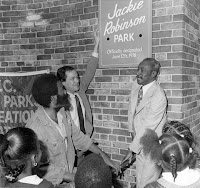 The purpose of the Underground Railroad Educational and Cultural (URR) Program is to help preserve the Underground Railroad’s legacy and to help demonstrate how the Underground Railroad’s widespread operations network transformed our Nation. In addition, the URR also promotes the formation of public- private partnerships to help disseminate information regarding the Underground Railroad throughout the United States, including lessons to be drawn from the history of the Underground Railroad. Applications are due by July 30, 2009.
The purpose of the Underground Railroad Educational and Cultural (URR) Program is to help preserve the Underground Railroad’s legacy and to help demonstrate how the Underground Railroad’s widespread operations network transformed our Nation. In addition, the URR also promotes the formation of public- private partnerships to help disseminate information regarding the Underground Railroad throughout the United States, including lessons to be drawn from the history of the Underground Railroad. Applications are due by July 30, 2009.
Eligible Applicants: Nonprofit educational organizations that are established to research, display, interpret, and collect artifacts relating to the history of the Underground Railroad. Other: Each nonprofit educational organization awarded a grant under this competition must create an endowment to fund any and all shortfalls in the costs of the on-going operations of the facility.
Grantees must establish a network of satellite centers throughout the United States to help disseminate information regarding the Underground Railroad. These satellite centers must raise 80 percent of the funds required to establish the satellite centers from non-Federal public and private sources. In addition, grantees must establish the capability to electronically link the facility with other local and regional facilities that have collections and programs that interpret the history of the Underground Railroad.
Applications for grants under the Underground Railroad Educational and Cultural Program–CFDA number 84.345A–must be submitted electronically using e-Application, accessible through the Department’s e-Grants Web site at: http://e-grants.ed.gov/. While completing your electronic application, you will be entering data online that will be saved into a database. You may not e-mail an electronic copy of a grant application to us.
As part of the application process, applicants will be required to document their ability to create an endowment, establish satellite centers, and establish the electronic capability described above. For specific requirements on reporting, please go to Reporting Forms
Document Type: Grants Notice
Funding Opportunity Number: ED-GRANTS-061509-001
Opportunity Category: Discretionary
Posted Date: Jun 15, 2009
Creation Date: Jun 15, 2009
Original Closing Date for Applications: Jul 30, 2009
Current Closing Date for Applications: Jul 30, 2009 Applications Available: June 15, 2009. Deadline for Transmittal of Applications: July 30, 2009.
Archive Date: Aug 29, 2009
Funding Instrument Type: Grant
Category of Funding Activity: Education
Category Explanation:
Expected Number of Awards: 2
Estimated Total Program Funding: $1,945,000
Award Ceiling:
Award Floor:
CFDA Number(s): 84.345 —- Underground Railroad Educational and Cultural Program
Cost Sharing or Matching Requirement: Yes
Full Announcement [pdf]






